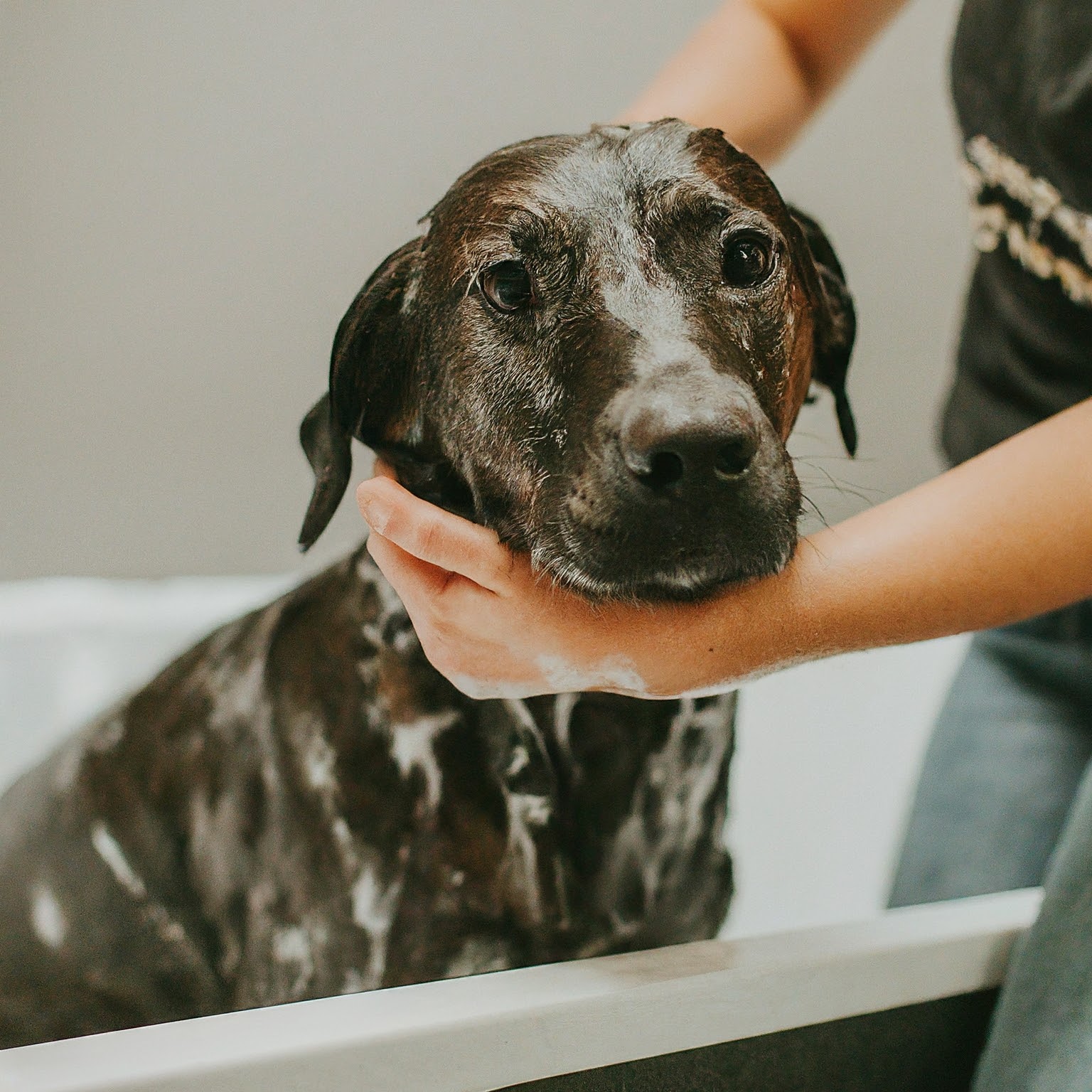
Giving your dog a bath is a regular hygiene practice that will keep your dog’s coat clean and healthy, and remove dirt, parasites, or other elements that may become trapped in the fur.
Although dogs don’t need to be bathed daily, their coat, environment, and other factors can influence how often they should be bathed. Consult your veterinarian to determine how often your dog should be washed.
Before You Start
Proper preparation can make the bathing process easier for both you and your dog.
A bathtub is usually the easiest place to bathe your dog, although very small dogs can be bathed in a sink. If you’re using your bathtub at home, this can be hard on your back and knees and leave a mess to clean up.
Some pet supply stores offer self-service dog baths that you can use for a small fee. It’s less expensive than paying for a groomer and can help avoid a mess at home.
If you choose to bathe your dog outdoors, remember that cold water isn’t fun for most dogs. Additionally, cold water won’t clean your dog as well.
Make sure the weather is warm so your dog doesn’t get too cold, or use heated water so your dog can have a pleasantly warm bath.
If you’re paying for the use of a self-service dog bath, these products may be ready and available for your use. If bathing your dog at home, make sure to gather your materials in advance so you don’t have to search for things later on.
Instructions on How to Give your Dog a Bath
What You'll Need
Equipment / Tools
- Equipment / Tools
- Soft and absorbent towels
- Brushes and combs suitable for your dog’s coat type
- Bath mat
- Apron and/or old clothes
Materials
- Dog shampoo
- Eye lubricant or mineral oil
Step-by-Step
- Brush your dog before starting the bath. Make sure to remove any knots or tangles, as these are harder to deal with once your dog is wet.
- Apply a strip of artificial tears ointment or a few drops of mineral oil to each eye. This will help protect the eyes from shampoo.
- While you can use tear-free baby shampoo, a shampoo specifically designed for dogs is ideal.
- Thoroughly soak your dog from head to toe with warm water. This works best if you use a handheld sprayer, but you can also pour water from a jug or bucket. Always test the temperature on your skin before applying it to your dog.
- Many dogs have water-resistant coats, so thorough immersion is usually necessary to penetrate the fur. Be sure to avoid the eyes and inside of the ears. Your dog will instinctively want to shake off the water. Keeping a hand on top of your dog’s head can help prevent this.
- Apply shampoo to your dog’s coat. Avoid the eyes, face, and genital area. Use enough shampoo to create lather.
- Apply small amounts of shampoo at a time to avoid overusing. One option is to mix two parts shampoo with one part water so that a more generous amount can be applied.
- Add the mixture to a spray bottle or a large plastic cup for easier application. Remember to be careful around the face and eyes.
- Scrub, scrub, and massage your dog for several minutes. You can use your fingers, just like when washing your own hair. Your dog will likely even enjoy this part. Remember to clean the paws as well.
- Ideally, you should allow the shampoo to remain on your dog’s coat for 10 to 15 minutes before rinsing, especially if it’s medicated shampoo. Take advantage of this time to clean your dog’s ears.
- You can also use a rubber or plastic grooming tool with small protrusions specifically made for a dog’s bath. It provides an extra massage on your dog’s skin and helps lather with the shampoo.
- Apply a stream of water to your dog’s coat, avoiding the eyes and ears. Rinse thoroughly all the shampoo from your dog’s coat. A handheld shower sprayer works best for this; rinsing with a cup, jug, or bucket will take longer.
- Remember to thoroughly rinse the paws and any folds or crevices in your dog’s skin. It’s very important to remove all shampoo residue from your dog.
- After initially rinsing your dog with warm/hot water, use warm or slightly cool water to help remove shampoo residue and close the pores.
- First, step back and let your dog shake a few times. Then, towel dry excess water from your dog’s coat. Lay a towel on the floor and let your dog do the same.
- Many dogs will instinctively rub against the towel and continue to shake off water. Then, you can proceed with further towel drying.
- If your dog tolerates it, you can try using a dryer. Make sure to use a dryer with very low heat or no heat. If you bathed your dog in a self-service tub, there might be a forced air dryer available.
- Be cautious, these dryers are powerful. Only increase the intensity as far as your dog tolerates and avoid the face, eyes, and ears area.
Once your dog is completely dry, brush the coat thoroughly. Wipe away any greasy film around your dog’s eyes with a damp cloth. Try to keep your dog indoors until fully dry, otherwise, you’ll have a dirty dog again in no time.
Preventing Issues with Your Dog During Bath Time
Some dogs simply hate baths. It can feel like a wrestling match or be so messy and time-consuming that you want to give up. If this is the case, it might be time to visit a groomer.
Professional groomers are recommended for certain breeds that have long coats requiring regular trims. If you’re determined to bathe at home, keep trying and come prepared with dog treats.
